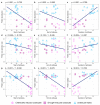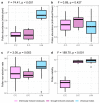Cosexuality Reduces Pollen Production and Fitness in Cannabis sativa L
- PMID: 37960087
- PMCID: PMC10648298
- DOI: 10.3390/plants12213731
Cosexuality Reduces Pollen Production and Fitness in Cannabis sativa L
Abstract
Cannabis sativa L. is cultivated globally for its cannabinoid-dense inflorescences. Commercial preference for sinsemilla has led to the development of methods for producing feminized seeds through cross-pollination of cosexual (masculinized) female plants. Although the induction of cosexuality in Cannabis plants is common, to date, no work has empirically tested how masculinization of female Cannabis plants impacts male flowering, pollen production, pollen fitness, and related life-history trade-offs. Here, we cultivated a population of Cannabis plants (CFX-2) and explored how the route to cosexuality (drought vs. chemical induction) impacted flowering phenology, pollen production, and pollen fitness, relative to unsexual male plants. Unisexual males flowered earlier and longer than cosexual plants and produced 223% more total pollen (F2,28 = 74.41, p < 0.001), but per-flower pollen production did not differ across reproductive phenotypes (F2,21 = 0.887, p = 0.427). Pollen viability was 200% higher in unisexual males and drought-induced cosexuals (F2,36 = 189.70, p < 0.001). Pollen non-abortion rates only differed in a marginally significant way across reproductive phenotypes (F2,36 = 3.00, p = 0.06). Here, we demonstrate that masculinization of female plants impacts whole-plant pollen production and pollen fitness in Cannabis sativa.
Keywords: Cannabis sativa; cosexual; dioecy; phenology; pollen; sexual lability.
Conflict of interest statement
The authors declare no conflict of interest.
Figures





Similar articles
-
Methods for characterizing pollen fitness in Cannabis sativa L.PLoS One. 2022 Jul 7;17(7):e0270799. doi: 10.1371/journal.pone.0270799. eCollection 2022. PLoS One. 2022. PMID: 35797371 Free PMC article.
-
Hermaphroditism in Marijuana (Cannabis sativa L.) Inflorescences - Impact on Floral Morphology, Seed Formation, Progeny Sex Ratios, and Genetic Variation.Front Plant Sci. 2020 Jun 25;11:718. doi: 10.3389/fpls.2020.00718. eCollection 2020. Front Plant Sci. 2020. PMID: 32670310 Free PMC article.
-
Spatial seed and pollen games: dispersal, sex allocation, and the evolution of dioecy.J Evol Biol. 2010 Sep 1;23(9):1947-56. doi: 10.1111/j.1420-9101.2010.02057.x. Epub 2010 Jul 31. J Evol Biol. 2010. PMID: 20695970
-
Optimized guidelines for feminized seed production in high-THC Cannabis cultivars.Front Plant Sci. 2024 Oct 30;15:1384286. doi: 10.3389/fpls.2024.1384286. eCollection 2024. Front Plant Sci. 2024. PMID: 39539297 Free PMC article. Review.
-
Mechanisms and evolution of deceptive pollination in orchids.Biol Rev Camb Philos Soc. 2006 May;81(2):219-35. doi: 10.1017/S1464793105006986. Biol Rev Camb Philos Soc. 2006. PMID: 16677433 Review.
References
-
- Faux A.M., Draye X., Lambert R., d’Andrimont R., Raulier P., Bertin P. The relationship of stem and seed yields to flowering phenology and sex expression in monoecious hemp (Cannabis sativa L.) Eur. J. Agron. 2013;47:11–22. doi: 10.1016/j.eja.2013.01.006. - DOI
-
- Korpelainen H. Labile sex expression in plants. Biol. Rev. 1998;73:157–180. doi: 10.1111/j.1469-185X.1997.tb00028.x. - DOI
Grants and funding
LinkOut - more resources
Full Text Sources
Miscellaneous

